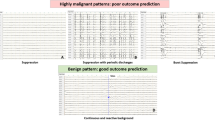Abstract
We evaluated whether we could predict the neurologic outcome in 55 out-of-hospital cardiac arrest patients using auditory brainstem responses (ABR). ABR patterns were classified into one of 3 types by evaluation of 5 components: type 1, with all 5 components; type 2, lack of at least one response between the 2nd and 5th components; type 3, with only the first component or no response. The relation between the ABR patterns on the 3rd day following resuscitation and the neurologic outcome on hospital discharge was evaluated. The specificity that the 5 awake patients had type-1 ABR was 38%. The sensitivity that the 10 brain dead patients had type-3 ABR was 60%. In the type-1 ABR patients, the negative predictive value that the patients were awake was 100%. In the type-3 ABR patients, the negative predictive value that the patients became brain dead was 90.9%. These results suggest that ABR on the 3rd post-resuscitation day may not be useful for predicting if patients are awake or become brain dead, although the loss of components may be a sign of morbidity, and the presence of the 2nd or later components indicates possible future prevention of brain death.
Similar content being viewed by others
References
Cerebral Resuscitation Study Group of the Belgian Society for Intensive Care (1988) predictive value of Glasgow coma score for awakening after out-of-hospital cardiac arrest. Lancet 8578:137–140
Levy DE, Caronna JJ, Singer BH, Lapinski RH, Frydman H, Plum F (1985) Predictive outcome from hypoxic-ischemic coma. JAMA 253:1420–1426
Bedell SE, Delbanco TL, Cook EF, Epstein FH (1983) Survival after cardiopulmonary resuscitation in the hospital. N Engl J Med 309:569–576
Longstreth WT Jr, Diehr P, Inui TS (1983) Prediction value of awakening after out-of-hospital cardiac arrest. N Engl J Med 308:1378–1382
Brain resuscitation clinical trial I study group: Steering committee: Abramson NS, Safar P, Detre KM, Kelsey SF, Monroe J, Reinmuth O, Snyder JV (1985) Neurologic recovery after cardiac arrest: Effect of duration of ischemia. Crit Care Med 13:930–931
Longstreth WT Jr, Inui TS, Cobb LA, Copass MK (1983) Neurologic recovery after out-of-hospital cardiac arrest. Ann Intern Med 98 [part 1]:588–592
Pionkowski RS, Thompson BM, Gruchow HW, Aprahamian C, Darin JC (1983) Resuscitation time in ventricular fibrillation—A prognostic indicator. Ann Emerg Med 12:733–738
Scollo-Lavizzari G, Bassetti C (1987) Prognostic value of EEG in post-anoxic coma after cardiac arrest. Eur Neurol 26:161–170
Christianto BL (1984) Measurements of brain-stem auditory evoked potentials in patients with spontaneous intracerebral hemorrhage. J Neurosurg 60:548–552
Mjøen S, Nordby HK, Torvik A (1983) Auditory evoked brainstem responses (ABR) in coma due to severe head trauma. Acta Otolaryngol 95:131–138
Fisher B, Peterson B, Hicks G (1992) Use of brainstem auditory-evoked response testing to assess neurologic outcome following near drowning in children. Crit Care Med 20:578–585
Kerimli B, Kampschulte S, Safar P: Cardiac arrest from exsanguination in dogs: Evaluation of resuscitation methods. Acta Anaesthesiol Scand 29:183–190
Safar P: resuscitation from clinical death: pathophysiologic limits and therapeutic potentials. Crit Care Med 16:923–941
Morimoto Y, Kemmotsu O, Kitami K, Matsubara I, Tedo I (1993) Acute brain swelling following out-of-hospital cardiac arrest: Pathogenesis and outcome. Crit Care Med 21:104–110
Snyder BD, Gumnit RJ, Leppik IE, Hauser WA, Loewenson RB, Ramirez-Lassepas M (1981) Neurologic prognosis after cardiopulmonary arrest: IV. Brainstem reflexes. Neurology (Ny) 31:1092–1097
Steen-Hansen JE, Hansen NN, Vaagenes P, Schreiner B (1988) Pupil size and light reactivity during cardiopulmonary resuscitation. Crit Care Med 16:69–70
Ottaviani F, Almadori G, Calderazzo AB, Frenguelli A, Paludetti G (1986) Auditory brainstem (ABRs) and middle latency auditory responses (MLRs) in the prognosis of severely head-injured patients. Electroenceph Clin Neurophsiol 65:196–202
Kaga K, Nagai T, Takamori A, Marsh RR (1985) Auditory short, middle, and long latency responses in acutely comatose patients. Laryngoscope 95:321–325
Karnaze DS, Marshall LF, McCarthy CS, Klauber MR, Bickford RG (1982) Localizing and prognostic value of auditory evoked responses in coma after closed head injury. Neurology 32:299–302
Morimoto Y, Gando S, Matsubara I, Tedo I, Kemmotsu O (1990) Evaluation of consciousness disturbances by middle latency response (MLR) and slow vertex response (SVR) in man (in Japanese with English abstract), Kyukyuigaku (Jpn J Acute Med) 14:483–488
Author information
Authors and Affiliations
About this article
Cite this article
Morimoto, Y., Kemmotsu, O., Kitami, K. et al. Auditory brainstem responses after out-of-hospital cardiac arrest: Are they useful for outcome prediction?. J Anesth 9, 22–26 (1995). https://doi.org/10.1007/BF02482030
Received:
Accepted:
Issue Date:
DOI: https://doi.org/10.1007/BF02482030



